

Braj Bhasha. Braj Bhasha (Devanagari: ब्रज भाषा), also called Brij Bhasha (बॄज भाषा), Braj Bhakha (ब्रज भाखा), or Dehaati Zabaan (देहाती ज़बान, 'country tongue'), is a Western Hindi language closely related to Hindustani.
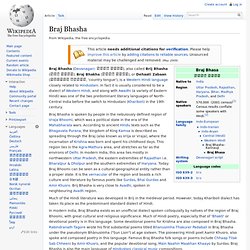
Hindi language (generic) Hindi, in the broad sense, is a dialect continuum within the Indo-Aryan language family in the northern plains of India, in what is commonly called the "Hindi Belt".
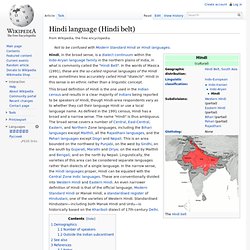
In the words of Masica (1991), these are the so-called regional languages of the Hindi area, sometimes less accurately called Hindi "dialects". Hindi in this sense is an ethnic rather than a linguistic concept. Bagheli language. Hindi. Related languages and dialects[edit] Standard Hindi is mutually intelligible with the other standardised register of Hindustani, Urdu, which is associated with the North Indian Muslim community.
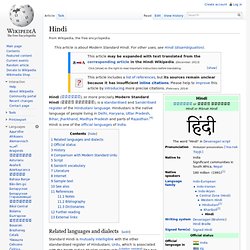
[citation needed] The two standards are nearly identical in structure and grammar. Mutual intelligibility decreases in literary and specialised contexts, which rely on educated vocabulary drawn from different sources; Hindi drawing its specialised vocabulary from Sanskrit, whilst Urdu does so from Persian and Arabic. In their colloquial forms, the two varieties are nearly indistinguishable. Sansi language. Ethnologue sees it as a Hindustani language (Western Hindi).[2] Some sources also mention it as a dialect of the Rajasthani language.[3] Kabutra, spoken by a thousand people in Pakistan, is mutually intelligible.

It is spoken by about sixty thousand speakers mainly in Rajasthan, Haryana, Punjab, and Delhi states of India. As a language, Sansiboli is not confined to any particular geographical boundary. It has benefitted from various sources, absorbed regional colors, and imbibed influence from neighboring languages and dialects. Haryanvi language. Haryanvi (Devanagari: हरियाणवी hariyāṇvī or हरयाणवी harayāṇvī) is an Indo-Aryan language.
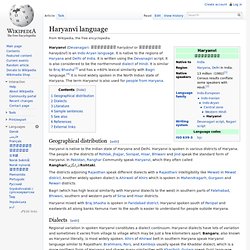
It is native to the regions of Haryana and Delhi of India. It is written using the Devanagiri script. It is also considered to be the northernmost dialect of Hindi. It is similar to Braj Bhasha[3] and has a ≈60% lexical similarity with Bagri language.[4] It is most widely spoken in the North Indian state of Haryana. The term Haryanvi is also used for people from Haryana. Bhalay-Gowlan language. Uttar Pradesh. Uttar Pradesh /ˈʊtər prəˈdɛʃ/ (Hindi: उत्तर प्रदेश, Urdu: اتر پردیش lit.

"Northern Province"), abbr. UP, is a state located in northern India. It was created on 1 April 1937 as the United Provinces, and was renamed Uttar Pradesh in 1950. Domari language. Domari is an Indo-Aryan language, spoken by older Dom people scattered across the Middle East.
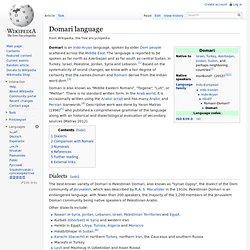
The language is reported to be spoken as far north as Azerbaijan and as far south as central Sudan, in Turkey, Israel, Palestine, Jordan, Syria and Lebanon.[1] Based on the systematicity of sound changes, we know with a fair degree of certainty that the names Domari and Romani derive from the Indian word ḍom.[3] Domari is also known as "Middle Eastern Romani", "Tsigene", "Luti", or "Mehtar". There is no standard written form. In the Arab world, it is occasionally written using the Arabic script and has many Arabic and Persian loanwords.[4] Descriptive work was done by Yaron Matras (1996)[5] who published a comprehensive grammar of the language along with an historical and dialectological evaluation of secondary sources (Matras 2012).
Dialects[edit] Other dialects include: Some dialects may be highly divergent and not mutually intelligible. Comparison with Romani[edit] Bundeli language. Urdu. Urdu (/ˈʊərduː/; Urdu: اُردُو ALA-LC: Urdū; IPA: [ˈʊrd̪uː] ( Urdu and Hindi are nearly identical in basic structure and grammar, and at a colloquial level also in vocabulary and phonology.
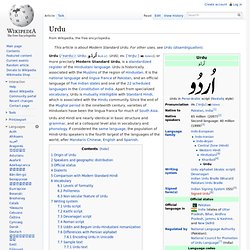
If considered the same language, the population of Hindi-Urdu speakers is the fourth largest of the languages of the world, after Mandarin Chinese, English and Spanish. Origin of Urdu[edit] The word Urdu is derived from the same Turkic word ordu (army) that has given English horde.[8] Hindustani language. History[edit] Early forms of present day Hindustani emerged from the Middle Indo-Aryan apabhramsha vernaculars of North India in the 7th–13th centuries CE.[16] Amir Khusro, who lived in the 13th century CE during the Delhi Sultanate period in North India, used these forms (which was the lingua franca of the period) in his writings and referred to the language as Hindavi.[16] The Delhi Sultanate, which comprised several Turkic and Persian dynasties that ruled from Delhi, was succeeded by the Mughal Empire in 1526.
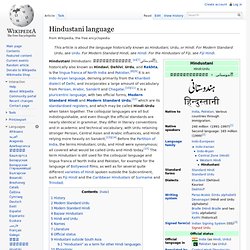
The phrase Zabān-e Urdu-e Mo'alla written in Nasta'liq calligraphy Although the Mughals were of Timurid (Gurkānī) Turko-Mongol descent,[17] they were Persianized, and Persian had gradually become the state language of the Mughal empire after Babur.[18][19][20][21] As an emerging common dialect, Hindustani absorbed large numbers of Persian, Arabic, and Turkic words, and as Mughal conquests grew it spread as a lingua franca across much of northern India. Modern Standard Urdu[edit] Prakrit. Prakrit (also transliterated as Pracrit) (Sanskrit: prākṛta प्राकृत, Shauraseni:pāuda पाउद, Maharashtri:pāua पाउअ) is the name for any of several Middle Indo-Aryan vernacular languages, derived from dialects of Old Indo-Aryan languages,[1][2]:p.3 particularly from Sanskrit.

The Ardhamagadhi language ("half Magadhi"), an archaic form of the Magadhi language which was used extensively to write Jain scriptures, is often considered to be the definitive form of Prakrit, while others are considered variants thereof. Prakrit grammarians would give the full grammar of Ardhamagadhi first, and then define the other grammars with relation to it. The word Prakrit itself has a flexible definition, being defined sometimes as "original, natural, artless, normal, ordinary, usual", or "vernacular", in contrast to the literary and religious orthodoxy of Sanskrit.
Alternatively, Prakrit can be taken to mean "derived from an original," which means evolved in natural way. Etymology[edit] Some scholars[who?] Kannauji. Kannauji language is an Indo-Aryan language spoken in parts of the Indian state of Uttar Pradesh. Kannauji is closely related to Hindustani, and some consider it to be a dialect of Hindustani, whereas others consider it a separate Western Hindi language.[2] Kannauji has about 6 million speakers. Kannauji has two dialects or variants of its own: Tirhari and Transitional Kannauji, which is between standard Kannauji and Awadhi. Geographical distribution[edit] Kannauji is not a standard dialect of Hindi and can be assumed to be the transitory phase between Braj Bhasha and Awadhi.
Khariboli dialect. Khariboli,[2] also known as Dehlavi, Kauravi, and Vernacular Hindustani, is a Western Hindi dialect spoken mainly in the rural surroundings of Delhi, the areas of Western Uttar Pradesh and the southern areas of Uttarakhand in India.[3][4] In academic literature, the term Kauravi (कौरवी) is sometimes applied to the specific Khari dialect spoken in the western parts of the Khari-speaking zone.
Although Khariboli and Standard Hindustani differ dialectically, Standard Hindustani is sometimes also referred to as Khariboli and regarded as the literary form of that dialect.[7] Khariboli is believed to have initially developed contemporaneously with the neighboring Awadhi and Braj dialects in the 900–1200 CE period. Khari contains some features, such as gemination, which give it a distinctive sound and differentiates it from standard Hindustani, Braj and Awadhi. Geographical distribution[edit] Persian language. "Farsi" redirects here.
For the village in Iran, see Farsi, Iran. Persian (/ˈpɜrʒən/ or /ˈpɜrʃən/; فارسی fārsi [fɒːɾˈsiː] ( )) is the predominant modern version of Old Persian, a southwestern Iranian language within the Indo-Iranian branch of the Indo-European languages. It is primarily spoken in Iran, Afghanistan (officially known as Dari since 1958 for political reasons),[7] and Tajikistan (officially known as Tajiki Persian since the Soviet era for political reasons),[8] and some other regions which historically came under Persian influence. There are approximately 110 million Persian speakers worldwide, with the language holding official status in Iran, Afghanistan and Tajikistan. Awadhi language. Chhattisgarhi language. Chhattisgarhi (Devanagari: छत्तीसगढ़ी) is the official language in the Indian state of Chhattisgarh, spoken by 17.5 million people.[1] It is an Eastern Hindi language with heavy vocabulary and linguistic features from Munda and Dravidian languages. [citation needed] Chhattisgarhi has been known by the name Khaltahi to surrounding hill-people and by the name Laria to Sambalpuri and Oriya speakers.
The Chhattisgarh region was known as Daksin Kosal in ancient time and mentioned in several historical records.Thus the classical name of Chhattisgarhi language is Kosali or Daksin Kosali with historical significance. Chamari language. Among the many purported languages found in the literature, some have proven to not exist. Others have very little evidence supporting their existence, and have been dismissed in later scholarship.
Below is a sampling of languages that have been claimed to exist in reputable sources but have subsequently been disproved or challenged. Malvi language. Romani language. Parya language. Parya (Russian: Парья язык) is a Central Indo-Aryan language spoken in parts of Uzbekistan and Tajikistan. Tajuzbeki (or Tadj-Uzbeki) was an alternative name coined by Bholanath Tivari for the same language. Much of the academic research in documenting and characterizing this Indo-Aryan isolate language was done by prominent Soviet linguist I. M. Oranski. Hindi languages. Languages[edit]